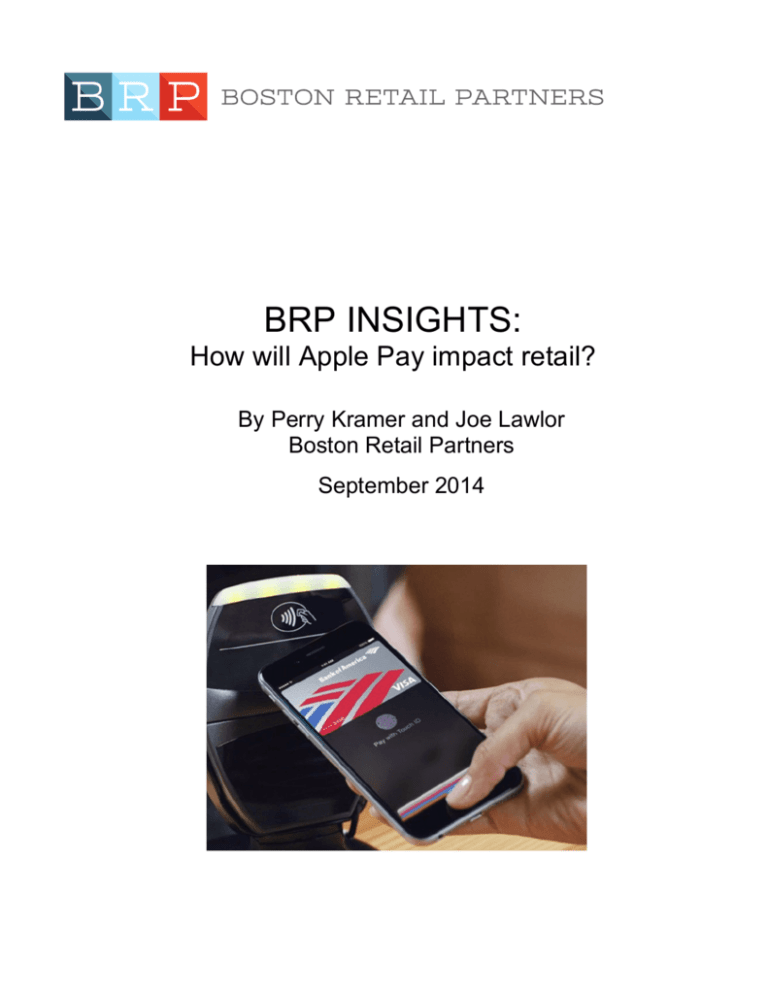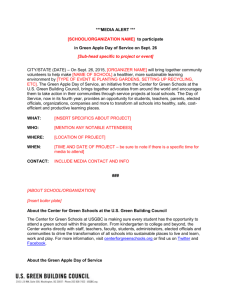
BRP INSIGHTS:
How will Apple Pay impact retail?
By Perry Kramer and Joe Lawlor
Boston Retail Partners
September 2014
Introduction
Despite the billions being spent by Samsung to combat its hype, four million preorders cemented Apple’s
newest smartphone offering as a perennial (and perhaps definitive) cash cow. The feature rich iPhone 6/6+,
buoyed by evangelistic early adopters and various carrier incentives, has customers rushing to buy what
has become a staple of the fashion forward and tech savvy. Furthermore, piquing the interest of consumers
and retailers alike is Apple’s late adoption of NFC (near field communication) technology integrated into the
proprietary Apple Pay app.
Fragmented Standards
Since 2010, NFC technology has been the
domain of Apple’s major market adversaries,
Samsung and Google. Now it appears that both
their respective efforts in establishing
relationships with card companies, offering digital
wallet apps, and encouraging businesses to
invest in NFC payment stations, have essentially
created the bedrock for Apple’s foray into the
payment industry.1 Apple Pay is now poised to
both accelerate the use of NFC, and circumvent
the initial investment risk its competitors fully
bore.
Past stumbling blocks for Samsung NFC
development ranged from a fragmented standards and certification systems, the overabundance of vendors
offering systems, and competing architectures of many of the rival payment systems in the space.2 Though
perhaps Samsung’s greatest misstep was underestimating the likelihood, and impact, of Apple’s initial
decision to not follow suit in adopting NFC in their own devises. This decision would relegate Samsung and
other competitors to work divided to establish NFC, while affording Apple the opportunity to invest in
iBeacon and Touch ID as a strategic stopgap measure.3 4
Low Market Acceptance of Mobile Payments
Apple’s patience opened the global market for its NFC enabled iPhone 6/6+, but the future of Apple Pay is
less than certain. To date, only 3% to 7% of U.S. and European consumers use their smartphone to make
physical purchases in-store.5 Therefore, the learning curve, which proponents of Google Wallet tried to
lower, will now be a yoke saddled by Apple as well. This would represent a process that needs to not only
educate customers, but also persuade them that the traditional doldrums and hassles of credit cards are
unacceptable. Worth noting is the fact that while mobile payments may hit $235 billion next year, $15 trillion
will still be spent the old fashion way with cash and credit cards due to their simple, reliable and ingrained
1
Demeritt, Clint. "Visa, Samsung Ink Global NFC Deal in What Could Signal Galaxy S4 Feature." TechRadar. N.p., 26 Feb. 2013. Web. 17
Evans, Jonny. "Your IPhone 5 Is Already Your 'iWallet' While Samsung Warns NFC Isn't Working Yet." Computerworld. N.p., 9 Oct. 2012.
Web. 17 Sept. 2014.
3
Yardley, James. "Apple May Have Just Killed NFC And Revolutionized Another Major Industry - Part 1." Seeking Alpha. N.p., 16 Sept. 2013.
Web. 17 Sept. 2014.
4
Hamblen, Matt. "Once Again, Apple Bypasses NFC in Its New IPhones." Computerworld. N.p., 11 Sept. 2013. Web. 17 Sept. 2014.
5
Frommer, Dan. "Why Apple’s Mobile-payments System Might Actually Work." Quartz. N.p., n.d. Web. 18 Sept. 2014.
2
BRP INSIGHTS: How will Apple Pay impact retail? | Page 2
nature.6 Additionally, only 220,000 stores will work with Apple Pay, which represents a mere 2.4% of the
roughly 7 million to 9 million merchants in the U.S. that accept credit cards.7 And as perhaps an indicator of
things to come, major players such as Wal-Mart and Best Buy have already publically distanced themselves
from NFC altogether. Furthermore, security concerns the public has with regard to using mobile devices for
electronic payments are exacerbated due to recent breaches of the Apple iCloud. Granted these are
separate Apple systems, and assurances have already been made to alleviate consumer fears.
With that said, this is why Apple Pay is (probably) an eventual
NFC Leader…
By the numbers, Apple’s 4 million iPhone 6/6+ first day preorders illustrates a clear adoration for a brand,
and these faithful are prime for assimilating its newest technology. The learning curve (or at least the
resistance to change) is more forgiving when dealing with the dogmatically loyal.
Yes, the number of retailers is currently limited, but the number 220,000 is growing every day and the armtwisting from major card companies to embrace NFC compatibility has already begun. The four major card
brands have been investing hundreds of millions of dollars in NFC technology over the last 5 years hoping
and waiting for a tipping point. The strong majority of industry experts agree that long-term there will be
several different mobile wallets, enabled by NFC, that eventually thrive in the industry.
MasterCard announced that by 2020, for European merchants to accept MasterCard and Maestro, they
must have equipped payment terminals to accept contactless cards and NFC equipped mobile phones.8
Moreover, Apple Pay has six major banks and three processors covering 80% of card issuers, and is expect
to have 14,000 card-issuing banks by next June, indicating
Tokenization (Wikipedia)
strides in infrastructure. Apple Pay has the strong likelihood of
being the tipping point for adoption of NFC-based payments in
Tokenization, when applied to data
the U.S. The technology works, as it is widely used in Asia.
security, is the process of
However, like all consumer-based technologies it requires
substituting a sensitive data
consumer adoption to succeed.
element with a non-sensitive
equivalent, referred to as a token,
And finally, the answer to security concerns in the light of recent
that has no extrinsic or exploitable
Apple iCloud gaffs boils down to one word, “tokenization.”
meaning or value. The token is a
Despite the public’s trust being nearly obliterated with the Target
reference (i.e. identifier) that maps
and Home Depot security issues of late, the truth remains that the
back to the sensitive data through a
scale difference between those tremendous miscues and leaked
tokenization system. The mapping
celebrity photos is large enough to be clearly distinguishable.
from original data to a token uses
Furthermore, the tokenization processes which Apple Pay will use
methods which render tokens
to protect data is more secure than what Apple uses in its iCloud.
infeasible to reverse in the absence
Additionally, it is much more secure than the much
of the tokenization system, for
missunderstood EMV implementations underway in the U.S.
example using tokens created from
Without EMV being combined with a combination of encryption
random numbers.
and tokenization, EMV is not as secure of a transaction as is
required in this ever changing and adapting world.
6
Bertoni, Steven. "Apple Pay Is Doomed Unless It Can Do These 7 Things." Forbes. Forbes Magazine, 9 Oct. 2014. Web. 19 Sept. 2014.
Davidson, Jacob. "Apple Pay Is Here." Time. Time, 9 Sept. 2014. Web. 18 Sept. 2014.
8
"MasterCard Fast Tracks Mobile Payment Acceptance in Europe Helping Europeans to Tap Everywhere by 2020." Europe Hub. MasterCard,
10 Sept. 2014. Web. 18 Sept. 2014.
7
BRP INSIGHTS: How will Apple Pay impact retail? | Page 3
How does Apple Pay impact traditional retailers?
It will be a very slowly but steadily impact on retailers. The immediate challenge is that the current system of
swiping isn’t broken. It’s a tad old fashion, but it’s no slower than tapping one’s phone, and from the
consumers perspective feels more secure. U.S. consumers are in store for major changes when EMV is
implemented and they may need to leave their cards inserted in a payment terminal for 6-10 seconds. In
contrast, NFC based transactions may be quicker based on a retailer’s implementation. NFC received a
huge shot in the arm with Apple championing the technology, but this will be a slow process of building
demand for something most consumers have zero bearing on. Implementation is a slow process that
presumably will not have U.S. retailers clamoring to make capital investments in compatible hardware.
Traditional retailers can feel secure in rebuffing Apple Pay, because without high Apple Pay membership
there’s obviously little, to no, chance of customer pushback for not installing the feature within their POS.
Retailers are faced with a very long change cycle in the payment area. Some progressive retailers have
invested in the NFC feature when purchasing new payment terminals as part of their EMV upgrades.
However, a large number have not updated their payment terminals and, quite often, the cost of an upgrade
can be four times the cost of purchasing the units with the feature. Additionally, the time to implement and
test changes such as NFC payments and EMV will generally range between 6-9 months, which is a major
investment for retailers who are always balancing change against the need to increase sales and margins.
Goodwill and marketing prowess will go a long way to reinvigorating NFC, but Apple will have an uphill
struggle pitching this tech. The bottom line is that Apple branding is not a reason for consumers to commit
to Apple Pay. Actual incentives, such as those given by all major card companies, also need to be part of
the equation.9 That said, where Apple Pay’s influence may be greatest felt is actually with online retailers.
Apple Pay will provide online shoppers an alternative to Google Wallet and PayPal, which in turn may spur
special deals and lowered transaction fees as these entities battle for market share.10
9
Hernandez, Will. "Apple at the ATM: Will Apple Pay Change the Conversation about Contactless Cash Transactions?" Atm Marketplace. N.p.,
11 Sept. 2014. Web. 19 Sept. 2014.
10
"How Apple Pay Could Change Retail | Echidna." Echidna. N.p., n.d. Web. 19 Sept. 2014.
BRP INSIGHTS: How will Apple Pay impact retail? | Page 4
About Boston Retail Partners
Boston Retail Partners (BRP) is an innovative and independent retail management consulting firm
dedicated to providing superior service and enduring value to our clients. BRP combines its consultants'
deep retail business knowledge and cross-functional capabilities to deliver superior design and
implementation of strategy, technology, and process solutions. The firm's unique combination of industry
focus, knowledge-based approach, and rapid, end-to-end solution deployment helps clients to achieve their
business potential. BRP’s consulting services include:
Strategy
Point of Sale (POS)
CRM
Order Management
Supply Chain
Business Intelligence
Mobile POS
Unified Commerce
eCommerce
Information Technology
Business Process Optimization
Store Systems and Operations
Customer Experience & Engagement
Merchandise Management
Private Equity
For more information or assistance on any of the topics covered in this paper, please contact:
Perry Kramer, Vice President
617-899-7543
pkramer@bostonretailpartners.com
David Naumann, Director of Marketing
(916) 673-7757
dnaumann@bostonretailpartners.com
Brian Brunk, Principal
(405) 590-0542
bbrunk@bostonretailpartners.com
Walter Deacon, Principal
(781) 337-2060
wdeacon@bostonretailpartners.com
Ken Morris, Principal
(617) 880-9355
kmorris@bostonretailpartners.com
Boston Retail Partners Headquarters
Independence Wharf, 470 Atlantic Ave., 4th Floor, Boston, MA 02210
www.bostonretailpartners.com
©2014 Boston Retail Partners. All rights reserved
No part of this publication may be reproduced or transmitted in any form or for any purpose without the expressed permission of
Boston Retail Partners. The information contained herein may be changed without prior notice.
BRP INSIGHTS: How will Apple Pay impact retail? | Page 5





